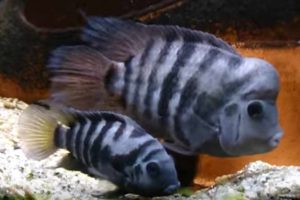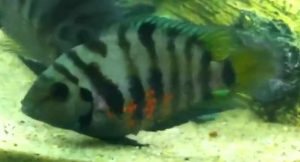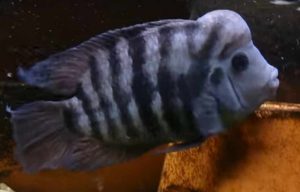The Convict Cichlid (Archocentrus nigrofasciatus)also known to tropical fish keeping enthusiasts as the Zebra cichlid, is found in the lakes, rivers, and streams of Central America, primarily from El Salvador to Guatemala on the Pacific coast, and from Honduras to Guatemala on the Atlantic side.
Although Convict cichlids are found in lakes, they prefer living in rivers and streams with rocky substrates and sunken branches where they can easily prey on small fish, insects, worms, crustaceans, plant matter, and algae.
Several color strains of Archocentrus nigrofasciatus exist in the wild such as the Honduran Red Point Convict found from Honduras south to Costa Rica, however both Amatitlania coatepeque from Lake Coatepeque in El Salvador, and Amatitlania kanna from Panama’s Atlantic coast which was originally identified as A. nigrofasciata, are now considered separate species.
Wild caught Convict Cichlids have 8 to 9 dark black vertical bars over a bluish gray body, a greenish tint on the fins, and a darker blotch on their operculum.
Males are larger but less colorful than the females and as they grow, develop a lump on their foreheads. Males also have more pointed dorsal, ventral, and anal fins.
Female Convict cichlids are colored a pink to bright orange around their ventral area and the dorsal fin, and have more intensely colored black bands on the body. Selective breeding has produced white, pink, and gold colored Convict cichlids which lack the distinctive black banding.
Archocentrus nigrofasciatus is an aggressive species that can tolerate a wide range of water conditions. They have been found in waters with a pH of 6.6-7.8, a GH from 63 to 77 ppm, and water temperatures from 79-84 degrees F. but they can also tolerate much cooler water. Their low care requirements make them an excellent beginner species for newcomers to cichlid fish keeping.
Convict Cichlids should be kept in an aquarium of at least 25 gallons with a fine gravel or sandy substrate, plenty of rocks, some driftwood roots, and a few hardy plants like Java Fern or Amazon Swords for them to hide among, and a good filtration system. Floating plants
are recommended as a form of cover and to diffuse overhead lighting. Because they come from moving streams and rivers, a power head or an outside canister filtration system is recommended to provide them with some current in the tank.
Convict Cichlids are notorious for rearranging their surroundings, so don’t expect them to leave the tank neat and tidy. This is another reason why canister filters are preferred for this species.
In general, Convict Cichlids are a relatively timid species but when they are breeding, they become extremely aggressive. A breeding pair is fearless and will attack any size fish without hesitation. For this reason, keeping them in a single species environment is recommended.
If you choose to keep them in a community environment with other larger cichlid species, a 55 gallon or larger tank is recommended. But, even then, don’t overcrowd the aquarium. Some tropical fish keeping enthusiasts recommend keeping Convict Cichlids with faster swimming species like mollies or barbs in a community tank with some success.
Convict Cichlids are are prolific breeders that are unbelievably easy to breed.
If you decide to breed them, make room for a batch of at least 20 to 30 juveniles within just a few weeks.
Convict Cichlids start spawning at a very young age, and when they do, they will breed with any female Convict Cichlid in the vicinity. Convict Cichlids will readily pair off to form a patriarch/matriarch family where both the male and female care for the young.
In the wild, Convict Cichlids will lay their eggs underneath rocky overhangs and in caves. In an aquarium environment, replicate these conditions by placing flat stones on top of each other, adding half of a clay flower pot to the tank, or cutting a section of PVC pipe and placing it in the tank. Don’t worry about placement, the fish will just move everything around to their liking anyway.
If you feed them plenty of food, within a few weeks you can expect to see a batch of eggs on the upper part of the cave. To promote breeding, increase the water temperature between 75-79°F. The eggs will hatch in 3 to 5 days and you can begin feeding the fry infusoria, freshly hatched brine shrimp, or finely crushed cichlid flakes almost immediately. The fry grow quickly and should be fed 3 or more times a day.
The parents are incredibly good parents and will guard the eggs and the fry to the death. They will also help the fry find food and will create pits for them to keep them safe as they mature.
In the wild, Convict Cichlids primarily feed on small insects, insect larvae, and small crustaceans. In an aquarium environment, they will eat just about anything you put in the tank. However, a quality cichlid flake or pellet should be their main diet with regular supplemental feedings of live, frozen, or freeze dried tubifex, bloodworms, brine shrimp, daphnia
, chopped earthworms, ocean plankton, etc.
Convict Cichlids are readily available in most tropical fish keeping shops at reasonable prices when they are 1-1/2″ to 2″ in size.
Minimum Tank Size: 30 gallons
Care Level: Easy
Temperament: Aggressive
Aquarium Hardiness: Hardy
Water Conditions: 68-82° F, KH 9-20, pH 6.5-8.0
Max. Size: 6″
Color Form: Gray, Black
Diet: Omnivore
Compatibility: Community or Single species tank
Origin: Central America
Family: Cichlidae
Lifespan: 8-10 years
Aquarist Experience Level: Beginner





